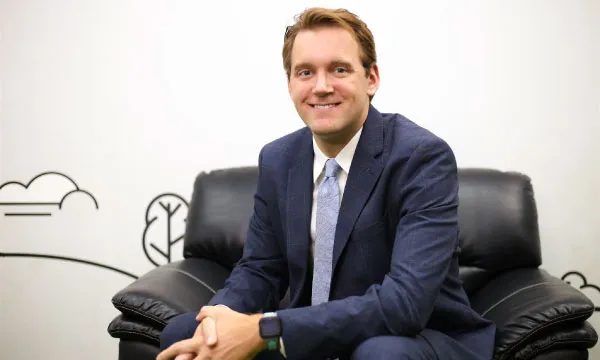
How a former Wall Street guy is disrupting Myanmar's microfinance landscape
Jason Loughnane will discuss how using big data can ease the credit appraisal process.
Jason Loughnane, Yoma Bank's head of digital credit, is building and deploying app-enabled loan products suitable for low-income borrowers and informal small businesses as part of a tech-powered push to expand the net of financial inclusion in one of the region’s most underserved segments.
From a prolific career as an investment banking analyst at Goldman Sachs in New York, Loughnane shifted to international microfinance. His career in microfinance has included stints with Global Communities, where he managed a portfolio of microfinance investments in the Middle East. He was with Grameen Foundation in East Africa as an investment officer and with Accion as a special projects manager for their portfolio partner in Yangon, Myanmar.
Loughnane earned his CFA Charter in 2016. He studied International Development and Economics at Johns Hopkins School of Advanced International Studies in Washington DC, receiving an MA in 2012.
In an interview with Asian Banking & Finance, Loughnane shares how he aims to radically transform banking in Myanmar by leveraging the nationwide accessibility of smartphones and mobile money agents to make safe, basic savings accounts and low-cost loan products easily accessible to every single person in the country.
What are your previous experiences and positions held that contributed to who you are as a banker/expert today?
I worked in Debt Capital Markets at Goldman Sachs in New York for four years, where I helped manage a portfolio of revolving credit facilities. I learned a ton about syndicated loans, relationship lending, and corporate debt finance. While I loved the intensity of the work, after a few years I knew I wanted a more socially meaningful career. I had maintained interest in Muhammad Yunus and Grameen Bank since they won the Nobel Peace Prize in 2006, so I decided to read up on microfinance and try to use my banking experience to work on financial inclusion for the poor. But first I wanted more formal training around the practice of international development.
I left Wall Street to pursue an MA at Johns Hopkins School of Advanced International Studies in 2010. During graduate school I worked with microfinance institutions across the Philippines, Vietnam, Tanzania, Colombia, and Honduras, and I absolutely loved learning about the industry. After graduation, I worked as a financial analyst for a development finance NGO in Washington DC for one year, overseeing a portfolio of equity investments in microfinance institutions across the Middle East. I quickly grew tired of being based in a head office, so I applied for and was offered a one-year overseas fellowship with the Grameen Foundation, which sent me to Nairobi to work as an investment officer focused on microfinance institutions and other impact investments.
While I loved my time in East Africa, I realised that I was much more passionate about microfinance operations than conducting due diligence and writing investment memos. I wanted to be as close as possible to the actual work with low-income customers. Around the time my fellowship was coming to an end, Accion was investing in a microfinance institution in Myanmar, and through some graduate school contacts I was recruited to work as the institution's Special Projects Manager, to be based in Yangon. For almost four years I worked on digital transformation of the institution's manual operations, with a goal toward growing our portfolio while reducing our operating expense ratio. I helped design and deploy a formal core banking system, built our partnership with a cash management agent network, and worked to introduce tablet-based loan applications to replace extensive paper-based processes.
Since my time in East Africa exposed me to M-Pesa, M-Shwari, and other algorithm-based digital credit appraisals, I had been interested in developing a purely digital loan product for microfinance borrowers, and Yoma Bank was working to introduce just such a product in 2018. I joined Yoma Bank as Head of Digital Credit in late 2018 to develop and grow the bank's digital loan portfolio, which in just one year since my joining now exceeds US$11 million in outstanding loans to over 12,000 borrowers.
What would you say are the best practices and digital strategies deployed by region's digitally dominant banks? Where does open banking fit in this agenda and how should banks capture the opportunities from this growing ecosystem?
The region's digitally dominant banks make the process of signing up for a bank account as painless as possible. Regulation plays a part, but allowing a customer to open a simple savings account using only a mobile phone, without needing to visit a branch in person, is crucial to increasing financial inclusion for underbanked populations.
Another important practice is to reduce or eliminate the transaction costs of saving in a formal bank account. This means no account minimums, monthly fees, or charges to withdraw or deposit money to a basic savings account. If customers feel a financial pain when depositing or withdrawing their own money, they will keep money under their mattress instead. Better for banks to offer a lower deposit interest rate than to impose pain points in the customers' savings journey.
Can you give us a glimpse of what you will share at the ABF Digital & Open Banking Conference 2019?
I'll discuss the challenge of lending to thin-file customers in a country with no credit bureau, including how microfinance institutions have historically tried to assess a borrower's capacity to repay, and how we're now using big data to remove the loan officer from the credit appraisal process.
I'll also talk about the ecosystem needed for a digital credit solution to succeed, including the significance of smartphone usage, mobile money penetration, and familiarity with agent banking amongst the mass market population.






















 Advertise
Advertise








